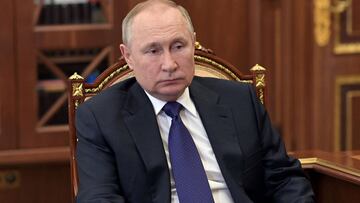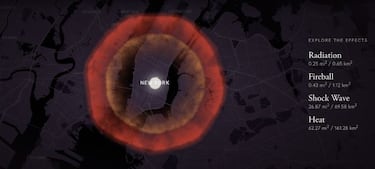How much damage does a nuclear weapon do?
Vladimir Putin has placed Russia's nuclear forces on "special alert", a move that UN Secretary General António Guterres has described as a "chilling development".


Russian President Vladimir Putin has caused global alarm by instructing his country’s military to put its nuclear forces on “special alert”, a decision he said was in response to “aggressive statements” from the West, amid international condemnation of Russia’s invasion of Ukraine. The move also comes after Putin last week warned “whoever tries to hinder” Russia in Ukraine can expect consequences “you have never seen in your history”.
Putin move a "chilling development" - UN chief
“This is a chilling development,” United Nations Secretary General António Guterres told a special session of the UN General Assembly on Monday. “The mere idea of a nuclear conflict is simply inconceivable. Nothing can justify the use of nuclear weapons.” The United States’ ambassador to the UN, Linda Thomas-Greenfield, on Sunday accused Putin of “continuing to escalate this war in a manner that is totally unacceptable”.
The United Kingdom’s defence secretary, Ben Wallace, has said he believes Putin’s raising of Russia’s nuclear alert is merely rhetoric aimed at distracting from a stuttering invasion. "He's made this comment. We keep it under review," Wallace told Sky News on Sunday. "But you know, what we shouldn't really forget is that this is a big attempt to distract away from his troubles in Ukraine by just deploying into the sort of media space these phrases."
In an interview with Business Insider, Tara Drozdenko, the director of the Union of Concerned Scientists' Global Security Program, agreed that a nuclear confrontation is unlikely, unless another nuclear power directly enters the conflict in Ukraine. "I hope it doesn't escalate, and I think there's a good chance that it doesn't, but the risk is real whenever nuclear-armed states are engaged in conflict with one another,” Drozdenko said. “Ukraine doesn't have nuclear weapons, so the risk of nuclear war in this scenario is if, somehow, the conflict escalated to pull in NATO countries or the US. That raises the risk of nuclear confrontation because some of the NATO countries have nuclear weapons."
See also:
- Nuclear arsenals around the world
- Ukraine jets strike Russian military convoy
- American veterans fighting Russia in Ukraine
- Vladimir Putin lookalike: the innocent man scared for his life
- Republican senators criticised for potentially endangering President Zelesnkyy
What is Russia's nuclear arsenal?
According to January 2022 figures compiled by the Bulletin of the Atomic Scientists in its annual Nuclear Notebook, Russia has a nuclear stockpile of 4,477 warheads. A signatory to the Treaty on the Non-Proliferation of Nuclear Weapons (NPT), the country has greatly reduced its nuclear arsenal from a 1980s high of around 40,000 warheads, just as its Cold War foe the US, which is also one of the 191 states to have signed the NPT, has cut its stockpile from around 30,000 in the 1960s to just under 4,000 today.
However, while the overall number of nuclear weapons in existence has fallen, their potency has increased markedly since atomic bombs were dropped on the Japanese cities of Hiroshima and Nagasaki at the end of the Second World War, causing over 200,000 deaths by the end of 1945, and many more thereafter. While these bombs had a strength of around 15 and 20 kilotons, respectively, Russia’s current nuclear warheads are mostly between 100 and 800 kilotons in strength, according to the Bulletin of the Atomic Scientists. The US' vary from around 100 to 1,200 kilotons, while the two other nuclear states in NATO alongside the Americans - the UK and France, who have significantly fewer warheads than the US and Russia - possess weapons in the low hundred kilotons.
“Modern weapons are 20 to 30 times more powerful than the bombs dropped on Hiroshima and Nagasaki,” Drozdenko warns. “If the US and Russia launched everything that they had, it could potentially be a civilization-ending event.” And even if only a single nuclear weapon were dropped on a large city today, the death toll would potentially be “measured in the millions rather than the tens or hundreds of thousands”, says the International Campaign to Abolish Nuclear Weapons (ICAN). The UN Office for Disarmament Affairs agrees that one nuclear bomb “can destroy a whole city, potentially killing millions, and jeopardizing the natural environment and lives of future generations through its long-term catastrophic effects”.
How does a nuclear attack unfold?
A nuclear weapon can be donated on the surface or in the air; the latter impacts a larger geographical area, and is how the Hiroshima and Nagasaki atomic bombs were used.
1. Fireball vaporises everything in its wake
According to a simulator created by the Outrider Foundation, a US-based body that campaigns against nuclear weapons and climate change, a 300-kiloton nuclear bomb detonated in the air would, within a fraction of a second of detonation, create a fireball measuring just over one square kilometre. This fireball would heat up to a temperature hotter than the sun, instantly vaporising everything inside it.
2. Heat burns everything in far wider area
Over a much wider radius than the fireball - a little over 160 square kilometres, according to the Outrider Foundation - the intense heat generated by the explosion would leave people with “severe or fatal third-degree burns”, while everything made of materials such as plastic, wood and fabric would catch fire. People outside this radius would still be likely to suffer first or second-degree burns. What’s more, the flash resulting from the explosion would temporarily blind anyone looking in its direction at the time of detonation.

3. Shockwave adds to destruction
By pushing back the surrounding air, the rapid expansion of the fireball would cause a shockwave measuring around 70 square kilometres. Hurricane-force winds would demolish buildings that do not have steel-reinforced concrete, and people in this area would be likely to be injured or killed by the collapsing structures and debris carried by the high winds. To make matters worse, the damage to healthcare workers and infrastructure would mean those injured by the explosion would be unlikely to be able to count on swift medical treatment.
4. Radioactive fallout
According to the Outrider Foundation, around 50% to 90% of those who initially survive the heat and shockwave would die of poisoning “within a few hours to a few weeks” from the extremely high levels of radiation emitted by the nuclear blast.
Furthermore, the mushroom cloud created by the explosion would carry radioactive debris high into the air and across large distances. Radioactive particles would remain in the environment, contaminating it for years to come; for example, they would be absorbed by crops and, as a result, work their way into our food chain. In the years after the blast, many people exposed to such radiation would die from cancers such as leukaemia.
This has been seen in Hiroshima and Nagasaki survivors. According to figures published by the International Committee of the Red Cross (ICRC) in 2015, nearly two-thirds of all deaths among Hiroshima survivors in the preceding 12 months were cancer-related; in the case of the Nagasaki atomic bomb, it was just over half. The ICRC also noted that children under 10 who were exposed to atomic radiation in 1945 went on to be four times more likely than the general population to be diagnosed with leukaemia.
Estimated death toll of nuclear attack on major US cities
Related stories
According to NukeMap, a tool that estimates the impact of an attack, just over one million people would be killed if a 300-kiloton nuclear bomb were to be dropped on New York City, while a further two million people would be left injured. In the US' capital city, Washington DC, there would be approximately 350,000 fatalities, with around 600,000 people injured.
It's important to note that the projected death toll offered by NukeMap - which was created by the nuclear weapons expert Alex Wellerstein, the author of the book Restricted Data: The History of Nuclear Secrecy in the United States - does not include those killed by longer-term fallout effects.

